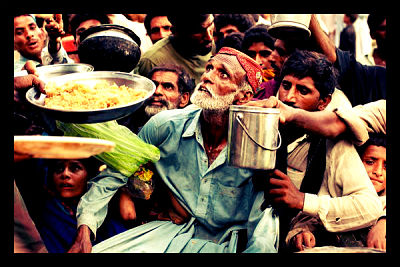Food Insecurity in Pakistan

Pakistan has been pummeled by three consecutive years of flooding resulting in destroyed crops and forced evacuations. Coupled with tribal violence this situation has prompted the UN to declare Pakistan in a state of food “emergency.” However, aid may be slow in coming.
Forty-five percent of Pakistan’s population depends on agriculture for their livelihoods. Flooding in 2007, 2010, and 2012 coupled with earthquakes in 2005 and 2008 severely affected Pakistan’s food production. Wheat production, a major component of Pakistan’s food supply, was affected in 2008 but has since recovered some. However, rice production, a significant export, is still down from its high. This Spring the Indus river, providing much of the irrigation for production areas in Pakistan’s coastal district is unusually low. The colder winter has delayed glacier melt which feeds the River. Scientists believe climate change will continue to affect glacier melt and lead to increased flooding and drought.
Malnourishment is another result of these natural disasters and unrest in Pakistan. Fifteen percent of Pakistani children are malnourished. The UN World Food Programme (WFP) works to combat this nutrient deficiency in Pakistan with locally produced products called “Wawa Mum” and “Acha Mum.” Programs providing children aged six to fifty-nine months with this nutrient-rich product has seen positive results. Reaching more children in the most remote parts of the country requires additional resources, however.
In addition to the crops lost to natural disasters the evacuation of rural populations also leads to food insecurity. The population dependent on sustenance farming is forced to abandon their production and livestock when moved to safe areas. The loss in this production and investment is difficult to monetize. Areas bordering Afghanistan affected by tribal violence and spill-over from conflict across the border also lead to evacuations and loss in property. Even when refugees are able to return to their homes their houses and property are often destroyed, making food production difficult if not impossible.
A program launched in May 2009 by the UN Food and Agriculture Organization (FAO) and implemented in conjunction with the WFP is designed to assist the rural population with food production and re-building local agricultural infrastructure. The 24.7 million Euro project targets families growing staple foods. In addition to this funding, the FAO works to assist agriculture production in conflict areas of Pakistan.
Despite these programs, the WFP chief says aid for Pakistan food security has been rerouted to assist with the Syrian refugee crisis. The WFP spends $19 million monthly on Syria operations. With the increasing violence in Syria, and the refugee numbers climbing, Pakistan may see a further drop in its food aid.
– Callie D. Coleman
Sources: Global Post, Food Security Portal, WFP
Photo: Spark
